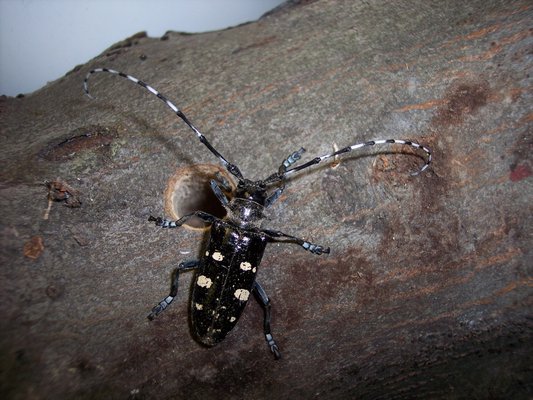
August is Tree Check Month, and the U.S. Department of Agriculture is using the occasion to ask New York State residents to help stop the spread of the Asian longhorned beetle.
The USDA’s Animal and Plant Health Inspection Service, or APHIS, noted that this is the best time to spot the round, drill-like holes made by the Asian longhorned beetle—an invasive pest that destroys trees. Suffolk County residents are among those especially urged to be watchful, along with residents of Kings, Queens and Nassau counties. The four counties are fighting an active beetle infestation that has resulted in the loss of 23,753 trees in the area to date, according to the USDA.
“If you love trees, now is the time to take 10 minutes and go outside and look for the signs of this invasive pest,” said Josie Ryan, APHIS’s national operations manager for the Asian longhorned beetle eradication program. “Look for round holes the size of a dime or smaller in tree trunks and branches. If you see them or black beetles that have long antennas with black and white bands, report them immediately.”
The Asian longhorned beetle has the potential to destroy millions of acres of America’s treasured hardwoods, including maple, birch, elm, willow, ash and poplar trees, according to the USDA, which noted that there is currently no cure to save infested trees, which need to be removed to keep the beetle from spreading to nearby trees, as well as to protect homes and other personal property, since infested trees will die and can drop branches.
“Trees infested by the beetle weaken and die over time and are more likely to fall or lose branches during high winds and storms,” Ms. Ryan said. “Since we’re in hurricane season, it’s wise to remove trees sooner than later. It’s possible to get rid of this destructive pest, but we need the public’s help to do so. To date, the beetle has been eradicated from Illinois and New Jersey.”
The beetle is slow to spread on its own during the early stages of an infestation, so early detection and reporting are critical to containing it, the USDA stated.
The beetle has distinctive markings that are easy to recognize: long antennae with black and white bands, longer than the insect’s body; a shiny, jet-black body, about 1 to 1.5 inches long, with white spots; and six legs with possible bluish-colored feet.
Signs of infestation include: wound exit holes, about the size of a dime or smaller, in tree trunks and branches; shallow oval or round scars in the bark, where the adult beetle has chewed an egg site; sawdust-like material, called frass, on the ground around the tree or in the branches; and dead branches or limbs falling from an otherwise healthy-looking tree.
The USDA asks anyone who sees signs of an infestation to take a photograph and to try to capture the insect by placing it in a container and freezing it. Then call 1-866-702-9938 or complete an online form at asianlonghornedbeetle.com.